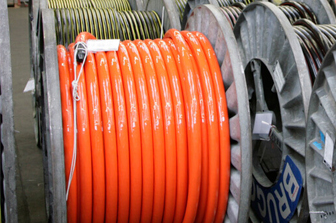The Main Use Occasions and Installation Precautions of Flame Resistant Cable
In fact, we are not unfamiliar with cables, and it is precisely because of the use of cables that they bring light to our dark night. There are many types of cables, such as power cables, wires and cables, fire resistive cables, etc. Because fire resistive cables have very good fire resistance, they are currently widely used in some high-rise buildings, subways, underground streets, and large power stations. So what are the conditions for the use of fire resistive cables?
Ⅰ. Conditions for using flame resistant cable
1. Long-term working temperature of flame resistant cable
(1) Low-halogen, low-smoke, flame-retardant PVC insulation and sheath: 70°C; halogen-free, low-smoke, flame-retardant polyolefin insulation and sheath: 90°C and 125°C.
(2) Polyethylene fluoride insulation and sheath: 70℃ and 105℃; cross-linked polyethylene insulation: 90℃.
(3) Fluoroplastic insulation and sheath: 220°C and 260°C; fluoroplastic insulation: 105°C; flame-retardant polyvinyl fluoride sheath: 90°C and 125°C.
2. Ambient temperature of flame resistant cable
(1) Flame-retardant PVC insulation and sheath: -40℃ for fixed laying; -15℃ for non-fixed laying.
(2) Fluoroplastic insulation and sheath: -60℃ for fixed laying; -20℃ for non-fixed laying.
Fire-resistant characteristics: Fire resistive cable refers to cables that can maintain safe operation for a certain period of time under flame combustion. They are divided into two levels, A and B. Class A flame temperature is 950-1000℃, continuous fire time is 90 minutes, and Class B flame temperature is 750 -800℃, continuous fire time 90 min.
Ⅱ. The main use occasions and installation precautions of flame resistant cable
1. When flame resistant cables are used in cable tunnels, cable interlayers with dense cables, or in flammable places such as oil pipes, oil depots, etc., Class A flame resistant cables should be selected first. In addition to the above cases and when the number of cables is small, Class B flame resistant cables can be used.
2. Flame resistant cables are mostly used as power supply circuits for emergency power supplies, which require normal operation in the event of a fire. Because the ambient temperature rises sharply during a fire, in order to ensure the transmission capacity of the line and reduce the voltage drop, for circuits with long power supply lines and strictly limited allowable voltage drops, the cross-section of the flame resistant cable should be enlarged by at least one level.
3. Flame resistant cables cannot be used as high-temperature cables. The fire resistive cable can still maintain the normal operation of the line for a period of time under burning conditions, which means that in case of fire, the fire-resistant cable will not burn all at once, and it can still maintain normal power supply for a period of time. This feature determines that flame resistant cables play an important role in modern cities and industrial buildings, because once a fire occurs, the power supply loops of the control, monitoring, guidance, and alarm systems must maintain normal operation.
4. In order to reduce the failure rate of cable joints in fire accidents, the number of joints should be reduced as much as possible during installation to ensure that the line can work normally in a fire. If branch wiring is needed, fire-proof the joints should be done.
Latest News & Blog
 English
English  français
français  Deutsch
Deutsch  العربية
العربية  tiếng việt
tiếng việt  ไทย
ไทย  čeština
čeština  Indonesia
Indonesia  Eesti
Eesti  български
български  slovenčina
slovenčina 



